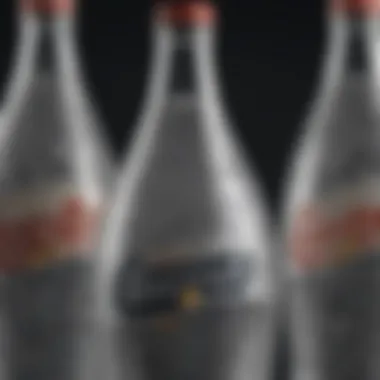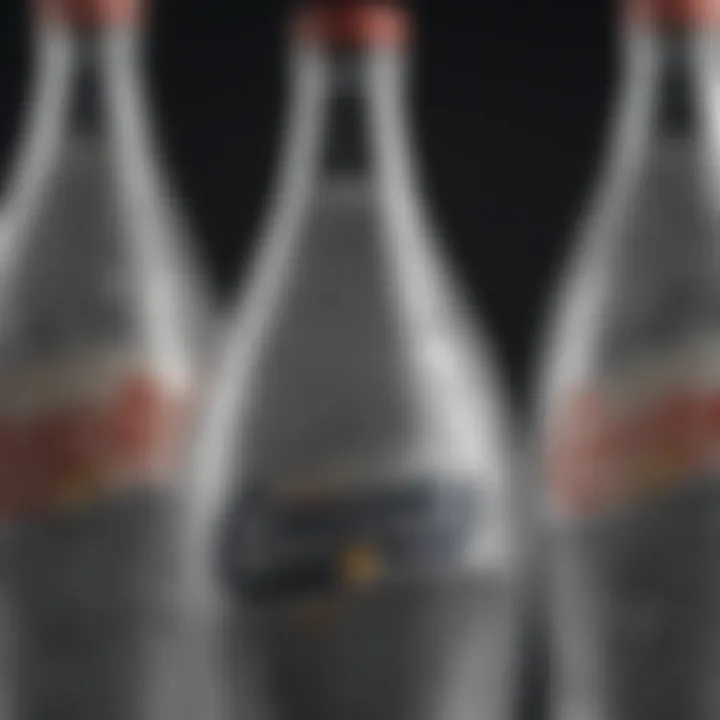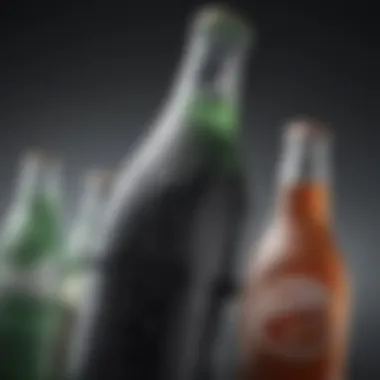The Dynamics of Carbonated Beverage Bottles


Intro
Carbonated beverage bottles, a common sight in many households, serve a crucial role in the global beverage industry. Their design and materials not only impact the efficiency of carbonation but also the environmental footprint associated with their lifecycle. Understanding the dynamics of these bottles is essential for informed consumption and responsible environmental stewardship.
As consumers become more aware of sustainability issues, the importance of evaluating beverage packaging is more relevant than ever. This article examines the various factors that influence the creation, usage, and disposal of carbonated beverage bottles, delving into the technological advancements and the environmental implications that arise from these objects we often overlook.
Foreword to Carbonated Beverage Bottles
Understanding the dynamics of carbonated beverage bottles requires a thorough grasp of their design, materials, and environmental considerations. These bottles are not just containers; they represent significant aspects of modern consumer behaviour and industrial practices. This section sets the stage for the detailed exploration of how these elements interplay, shaping the lifecycle from production to disposal. Furthermore, it highlights the critical role these bottles play in daily life and the choices consumers make regarding sustainability and environmental impact.
Definition and Purpose
Carbonated beverage bottles are specially designed containers made to hold drinks that are pressurized with carbon dioxide. The main purpose of these bottles is to maintain carbonation while being convenient for consumption. Their design must account for safety and structural integrity to withstand internal pressure. Common materials include plastic, glass, and aluminum, each serving a distinct purpose based on the beverage type and market preferences. This definition underscores the complexity behind what may seem like simple packaging.
Historical Context
The development of carbonated beverage bottles has evolved significantly since their inception. Initially, glass bottles were the dominant choice, dating back to the 18th century when carbonated water became popular. In the late 20th century, advancements in plastic manufacturing introduced PET bottles, revolutionizing the industry. This shift addressed consumer demand for lightweight and portable options. The move towards aluminum cans further diversified the market, appealing to a wider audience.
"The invention and evolution of beverage bottles reflect changes in technology, consumer habits, and environmental awareness."
As we move further into the article, we will explore the distinct materials used in these bottles, their manufacturing processes, and the broader implications for environmental sustainability.
Materials Used in Carbonated Beverage Bottles
The choice of materials for carbonated beverage bottles is foundational to their performance, consumer usability, and environmental impact. These materials directly influence the durability, safety, and ecological consequences associated with beverage packaging. Understanding the different materials allows for an informed comparison and evaluation of their benefits and limitations.
Plastic Bottles
Plastic bottles are widely used in the beverage industry primarily due to their lightweight nature and cost-effectiveness. The most common plastic employed is polyethylene terephthalate, known as PET. PET is favored for its transparency and ability to resist impact, making it ideal for transporting carbonated beverages.
However, while plastic bottles are convenient, they raise significant environmental concerns. For instance, plastic waste contributes to pollution in oceans and landfills. It is estimated that only about 29% of PET bottles were recycled in the United States in 2021, leading to prolonged degradation periods in the environment where plastics can exist for hundreds of years.
Despite these issues, advancements in recycling technology aim to improve the recovery rates of plastic bottles. Initiatives to produce biodegradable or compostable plastic variants are also gaining traction.
Glass Bottles
Glass bottles present a contrasting alternative to plastic ones. They have been a traditional choice for carbonated drinks, mainly due to their impermeability and the premium perception they give to beverages. Glass does not interact with the content, thus maintaining the beverage’s taste and carbonation over extended periods.
One significant advantage of glass is its recyclability. Glass can be recycled multiple times without losing its quality or purity, making it a more sustainable option when processed correctly. However, the bulkiness and weight of glass make transportation more energy-intensive, contributing to a higher carbon footprint during distribution.
"The sustainability of glass packaging hinges not only on the material's properties but also on consumer recycling behaviors and infrastructures in place for recycling."
Aluminum Cans
Aluminum cans are another prominent choice in the beverage industry. They provide an excellent barrier against light and oxygen, which helps in preserving the flavor and carbonation of drinks. Aluminum is also lightweight, which helps reduce transportation costs compared to glass.
The recycling rate for aluminum is noteworthy, with the American Aluminum Association reporting over 75% of aluminum ever produced still in use today. Recycling aluminum saves up to 95% of the energy needed to produce new cans, making it an efficient choice environmentally.
However, aluminum production does have significant environmental impacts, including greenhouse gas emissions and habitat disruption. Nevertheless, the recycling of aluminum cans remains a strong point in favor of its use, as the closed-loop system minimizes these adverse effects.
In summary, the materials used in carbonated beverage bottles—plastic, glass, and aluminum—each have unique attributes and varying effects on the environment. As consumer preferences evolve, so do innovations aimed at improving the sustainability and functionality of these materials.
Design and Engineering of Beverage Bottles
The design and engineering of carbonated beverage bottles are central to their functionality and usability. These designs must balance various factors, such as structural integrity, user ergonomics, and aesthetic considerations. Understanding these elements helps enhance consumer experience and safety, while also contributing to environmental sustainability.
Structural Integrity


Structural integrity is fundamental in bottle design to withstand the pressure created by carbonated beverages. Carbon dioxide is disolved under pressure in beverages, resulting in a potential build up of force inside the bottle. Engineers must consider factors such as material strength, thickness, and shape. Often, the design includes a pressure test phase to ensure the bottles can handle the internal stress during storage and transport.
Manufacturers like Coca-Cola and Pepsi utilize specific designs that enhance the durability of their plastic bottles. Innovations such as embossing or filament winding techniques help distribute the internal pressure more evenly across the bottle’s surface. The challenge is to ensure a balance between weight and strength. Lightweight materials may reduce shipping costs but can compromise structural integrity if not properly engineered.
Ergonomics and User Interaction
User interaction is another vital area of consideration in beverage bottle design. Efficient ergonomics help in the ease of handling and pouring. This often means creating contours or grips in the bottle design to facilitate a comfortable hold. Importantly, these designs should cater to a wide range of users. Functionality is improved when designs accommodate various hand sizes and strength levels.
When evaluating user interactions, researchers often conduct studies on how people interact with packaging. Feedback can influence design alterations, leading to bottles that are easier to open, pour, and recycle. Bottles such as those by Gatorade feature a squeeze design that allows for effective dispensing without the need for excessive force.
Aesthetic Considerations
Aesthetic considerations play a crucial role in marketing and consumer choices. A visually appealing bottle design can influence perceived quality and brand identity. This includes factors such as color, shape, and labeling. Bottles need to stand out on shelves while also reflecting brand values. For instance, brands like Fiji Water often utilize unique shapes that evoke natural elements to convey purity and quality.
The material choices can also affect aesthetics. Glass bottles often communicate premium quality, while sleek plastic designs are commonly seen as modern and practical. Ultimately, the design must balance attractiveness and functionality. Aspects of visual design can play a significant role in consumer trends, making it an area of continuous evolution in beverage packaging.
Good design is not just about aesthetics; it encompasses ease of use, safety, and environmental impact.
By focusing on structural integrity, user ergonomics, and aesthetics, beverage companies can create bottles that not only satisfy functional requirements but also resonate with consumers on an emotional level, enhancing brand loyalty and sustainability initiatives.
Manufacturing Processes
The manufacturing processes of carbonated beverage bottles play a vital role in ensuring product integrity and environmental sustainability. These processes determine the efficiency of production, the quality of the final product, and the adaptability of packaging solutions to market changes. Understanding these processes can lead to better design decisions, reduced waste, and enhanced recycling capabilities, which are especially relevant in today’s context of growing environmental concerns.
Blow Molding for Plastics
Blow molding is a prevalent manufacturing method used for creating plastic bottles. The process begins with heating and melting plastic resin, which is then formed into a parison—a hollow tube-like preform. Once the parison is ready, it is placed in a mold, and air is blown into it. This action expands the plastic to fill the mold's shape.
The blow molding process is efficient. It allows for mass production with minimal material wastage. Furthermore, this method provides flexibility in design, meaning brands can adapt their bottle shapes and sizes according to consumer preferences or branding strategies. However, the reliance on petroleum-based plastics brings attention to sustainability issues. Industry players are increasingly looking for alternatives to traditional petroleum resins to mitigate this impact.
Glass Blowing Techniques
Glass blowing techniques have a rich history in the manufacture of beverage bottles. These methods involve forming molten glass into specific shapes using a combination of blowing and molding. Glass is favored for its non-reactive nature and aesthetic qualities, providing both functionality and a premium feel.
In modern production, automated systems are often employed to enhance precision and efficiency. The adaptability of glass allows it to be molded into various designs, from slender shapes to robust structures. However, the production of glass bottles is energy-intensive, leading to significant environmental footprints compared to plastic. Understanding these techniques is essential for identifying future innovations in materials.
Canning Processes
Canning processes involve capturing beverages in aluminum or steel containers under sterilized conditions. This method is an effective way to preserve product freshness for extended periods without refrigeration. The process begins with the formation of the can, typically through stamping and forming metal sheets into cylindrical shapes.
Following the can's formation, it undergoes a cleaning and sterilization procedure. The beverage is then filled into cans before they are sealed hermetically. Canning is often favored for its lightweight nature, recyclability, and ability to go straight from supplier to consumer without requiring additional packaging. However, as with other manufacturing processes, there are challenges related to recycling and the need for improved sustainable practices.
Important Note: Understanding the intricate manufacturing processes of carbonated beverage bottles is crucial for fostering innovation and developing sustainable practices in the beverage industry.
Carbonation Mechanisms
The carbonation mechanisms of beverage bottles are essential for maintaining their quality and appeal. Understanding how carbonation works is not only important for the beverage industry but also for consumers who wish to enjoy their drinks at their best. Several elements comprise this topic, including the role of carbon dioxide, the effects of pressure and temperature, and the factors influencing shelf life and freshness. Each of these components plays a crucial part in delivering the expected sensory experience that carbonated beverages provide.
Understanding Carbon Dioxide
Carbon dioxide is a fundamental element in the carbonation of beverages. It is a colorless gas, and when dissolved in liquids, it creates the effervescence that is characteristic of sparkling drinks. The solubility of carbon dioxide in water is influenced by several factors, including temperature and pressure. Higher pressure allows more carbon dioxide to be dissolved, which is why beverages are often sealed under pressure during production. When the bottle is opened, the decrease in pressure causes some of the gas to escape, resulting in bubbles.
This process of carbonation not only impacts taste but also the mouthfeel of the beverage. The formation of bubbles releases volatile aromatics, enhancing flavor. Additionally, carbon dioxide can contribute to the juice of beverages, stimulating the palate and creating a perception of freshness. The dynamics of this gas should be comprehended by manufacturers to optimize product quality.
Pressure and Temperature Effects
The relationship between pressure and temperature is vital to the carbonation process. When beverages are manufactured, they are typically carbonated under high pressure, which allows for a greater concentration of carbon dioxide to be dissolved. As temperatures rise, the solubility of carbon dioxide decreases, leading to potential loss of fizz if the beverage is not stored correctly.
It is advisable to keep carbonated drinks in cool conditions to extend their shelf life. Conversely, exposing beverages to heat can cause rapid gas escape once the container is opened, diminishing the drink's freshness and carbonation. Understanding these factors is critical for both manufacturers and consumers, as it can inform proper storage practices to preserve beverage quality.


"Proper storage conditions play a critical role in the performance of carbonated beverages, directly impacting the consumer experience."
Shelf Life and Freshness
Shelf life refers to the duration during which a product can maintain its intended flavor, carbonation, and overall quality. Many factors can affect the shelf life of carbonated beverages, including packaging materials, storage conditions, and the type of beverage itself. For instance, plastic bottles may allow a small amount of gas to escape over time compared to glass or aluminum containers. This gradual decline in carbonation can lead to an increasingly flat taste.
When assessing freshness, it is essential to consider the date markings provided on beverage labels. These markings typically indicate when the drink is expected to maintain optimal quality. Consuming beverages before these dates ensures that consumers enjoy the effervescence and flavor intended by the manufacturer.
In summary, carbonation mechanisms are a multifaceted aspect of carbonated beverage bottles that significantly influence consumer experience. Understanding the role of carbon dioxide, the effects of pressure and temperature, and the importance of shelf life will help both producers and consumers appreciate these everyday products more profoundly. This knowledge can lead to better consumption practices and more informed choices.
Health and Safety Regulations
Health and safety regulations for carbonated beverage bottles are crucial. These standards ensure that the bottles are safe for consumers and suitable for the intended contents. Compliance with these regulations protects public health and enhances brand reputation.
FDA Regulations
The Food and Drug Administration (FDA) plays a significant role in regulating food and beverage packaging. Its guidelines cover materials used in packaging, ensuring they do not leach harmful substances into the beverage. Key aspects include:
- Material Safety: Only approved materials can be used in the production of beverage bottles. The FDA has a list of substances considered safe for use.
- Labeling Requirements: Proper labeling of ingredients and safety information is mandated to inform consumers about the product contents and any potential risks.
- Production Standards: The FDA sets forth stringent manufacturing processes to minimize contamination risk during production. This includes guidelines on cleanliness, equipment maintenance, and employee training.
"Ensuring compliance with FDA regulations not only safeguards consumer health but also aids in maintaining industry standards."
International Standards
Health and safety concerns extend beyond the United States. The international community has established several standards that govern the safety and quality of beverage bottles. Two major organizations contributing to these standards are the World Health Organization (WHO) and the International Organization for Standardization (ISO).
Some important international standards include:
- ISO 22000: This standard focuses on food safety management systems, addressing risks in the supply chain from production to distribution.
- WHO Guidelines: These guidelines offer recommendations on safe drinking water and the safe use of beverage packaging, which often intersects with bottle safety.
- Food Safety and Inspection Service (FSIS): This U.S. Department of Agriculture agency ensures that all food products are produced safely, including the packaging of carbonated beverages.
Compliance with these international standards reinforces the commitment to consumer safety while facilitating trade across borders. The landscape of health and safety regulations is constantly evolving, influenced by new scientific knowledge and consumer expectations.
Environmental Impact of Carbonated Beverage Bottles
The environmental impact of carbonated beverage bottles is a pressing concern in today’s world. These containers, found in almost every household, play a significant role in pollution and resource depletion. Understanding this impact is crucial for both consumers and manufacturers.
Carbonated beverage bottles often face scrutiny due to the materials used in their production. Plastic, glass, and aluminum are common choices that each have distinct environmental repercussions. The production processes of these materials consume energy, leading to greenhouse gas emissions, and they often rely on non-renewable resources. This article section will address how these factors contribute to a larger environmental crisis.
Furthermore, the lifecycle of these bottles—from manufacturing, distribution, consumption, to post-consumption—illustrates the complexity of their environmental footprint. An informed public is necessary for a shift towards more sustainable practices.
"It is not enough to reduce; we must also reuse and recycle to create a sustainable future."
Plastic Pollution
Plastic pollution is one of the most significant byproducts of carbonated beverage bottles. Each year, millions of plastic bottles are produced and consumed, with a large percentage ending up in landfills or oceans. Plastic bottles are not biodegradable; they can take centuries to break down, during which they can release harmful chemicals into the environment.
The impact on marine ecosystems is particularly alarming. Marine animals can mistake plastic for food, which can result in ingestion and, ultimately, death. Larger pieces of plastic can break down into microplastics, further contaminating the food chain.
To combat plastic pollution, it's essential to advocate for policies that emphasize recycling and responsible disposal. Consumers can play a role by choosing products in recyclable materials or supporting brands with sustainable packaging practices.
Recycling Challenges
Recycling carbonated beverage bottles presents several challenges. Although many materials used in beverage packaging are recyclable, the actual rates of recycling remain low. In the case of plastic bottles, various types and grades of plastics make the recycling process complicated. Many facilities are not equipped to handle multiple plastic types, leading to increased waste.
Additionally, consumer behavior significantly impacts recycling rates. People often do not return bottles for recycling or may not separate recyclables correctly. This complicates the sorting process and can contaminate entire batches of recyclable materials, rendering them useless.
Moreover, the economic viability of recycling centers can also impact their operations. If the market value for recycled materials drops, centers may not be able to operate, leading to increased waste.


Sustainability Practices
To mitigate the environmental impact of carbonated beverage bottles, various sustainability practices can be adopted. Companies are increasingly exploring the use of biodegradable materials that break down naturally, reducing plastic waste in the environment.
Additionally, many organizations are investing in technology aimed at improving recycling efficiency. For instance, smart recycling bins that educate users on proper disposal methods could improve recycling rates.
Lastly, consumer awareness plays a vital role in fostering a culture of sustainability. Encouraging consumers to choose brands that prioritize environmental practices can influence production and packaging decisions across the industry. As businesses respond to these shifts in consumer behavior, the potential for a more sustainable future with less environmental impact becomes more plausible.
Consumer Behavior and Trends
Understanding consumer behavior and trends is vital when analyzing carbonated beverage bottles. It reflects how consumers engage with these products, not only from a purchasing standpoint but also regarding their preferences and awareness of environmental issues. In recent years, the beverage industry has observed significant shifts in consumer demands. This transformation is influenced by several factors, including the increasing awareness of health issues and environmental sustainability.
Changing Preferences
The preferences of consumers have adapted to reflect a growing concern for health and wellness. Younger generations tend to favor lower-calorie options, eliminating sugary drinks from their diets. This trend has led brands like Coca-Cola and Pepsi to innovate with alternatives such as Coca-Cola Zero and Pepsi Zero Sugar. Additionally, many consumers now promote plant-based and organic options. These changing preferences significantly impact how companies design and market their products.
Environmental Concerns
Environmental concerns have surged in importance as climate change becomes a more pressing issue. Many consumers are now searching for brands that demonstrate a commitment to sustainability. They prefer companies that utilize recyclable materials in their packaging and exhibit transparency about their sourcing practices. Research indicates that businesses incorporating sustainability into their branding, such as Coca-Cola's World Without Waste initiative, tend to foster stronger loyalty among customers. This shift in consumer sentiment urges companies to improve their practices to align with a more environmentally conscious clientele.
Purchasing Patterns
Purchasing patterns reveal insights into how consumers interact with beverage products. Data indicates a notable increase in online purchases, driven primarily by the pandemic and the convenience it offers. Subscription services are also gaining traction, as they provide regular delivery of products without requiring repeat purchases at brick-and-mortar stores. Furthermore, there's an undeniable influence of social media on buying decisions. Reviews and recommendations found on platforms such as Facebook and Reddit can significantly impact consumers' choices.
"The purchasing trends of today are not only influenced by personal preference but also by a collective consciousness surrounding environmental impact."
Future Innovations in Beverage Packaging
Future innovations in beverage packaging are crucial to addressing persistent challenges in sustainability, consumer preferences, and technological advancements. This section discusses key advancements that could reshape how carbonated beverages are packaged and consumed. By focusing on biodegradable materials and smart packaging technologies, we can highlight the significant benefits for both manufacturers and consumers while considering the impact on the environment.
Biodegradable Materials
The shift toward biodegradable materials represents a profound change in beverage packaging. Traditional plastics, while convenient, contribute significantly to pollution. Biodegradable alternatives, such as polylactic acid (PLA) and other compostable substances, provide a potential solution. These materials offer several advantages:
- Reduced Environmental Impact: Biodegradable materials break down more quickly in composting environments, reducing landfill accumulation.
- Sustainable Sources: Many of these materials are derived from renewable resources, unlike petroleum-based plastics. This can lead to a lower carbon footprint over the product lifecycle.
- Consumer Acceptance: As environmental awareness increases, consumers are more likely to support brands using sustainable packaging. This trend encourages companies to explore these materials as a means to attract eco-conscious customers.
However, several considerations need attention. Biodegradable materials currently face challenges in terms of cost and availability. Many manufacturers need assistance integrating these materials into existing production processes while maintaining product integrity.
Smart Packaging Technologies
Smart packaging technologies are changing the landscape of beverage packaging, offering advanced features that enhance user experience. These innovations can include QR codes, NFC tags, and other digital tools that interact with the consumer's device. The potential benefits of smart packaging include:
- Enhanced Information Accessibility: Consumers can scan codes to access information about product sourcing, nutritional content, and recycling instructions.
- Improved Shelf-Life Management: Smart packaging can include sensors to monitor the condition of the beverage, alerting consumers when a product is near its expiration date or has lost freshness.
- Interactive Marketing: Brands can engage customers in innovative ways, providing exclusive content or promotions through smart packaging.
Despite these advances, the adoption of smart packaging faces challenges. Cost remains a barrier, particularly for smaller beverage manufacturers. There is also a need for standardization in how information is displayed and communicated to provide a uniform experience across products.
"Innovations in beverage packaging, particularly in sustainability, are essential for meeting consumer expectations in today’s market."
Epilogue and Recommendations
The topic of carbonated beverage bottles is important due to its implications on design, materials used, and environmental impact. These bottles are ubiquitous in modern society, linking together the consumer experience with significant environmental consequences. Understanding the life cycle of these containers can lead to more informed choices. Each aspect of this article contributes to a better grasp of how carbonated beverage bottles fit into both market trends and sustainability practices.
Summary of Key Findings
In this exploration, various critical points emerge. First, the materials used in the production of carbonated beverage bottles, such as plastic, glass, and aluminum, greatly affect their environmental footprint. Each material has its own set of advantages and challenges concerning recyclability and pollution. Secondly, the design aspects, including structural integrity and ergonomics, play a vital role in ensuring safety and user satisfaction. Additionally, the manufacturing processes must be optimized to lessen resource consumption and waste output.
Understanding the interplay between materials, design, and environmental impact is crucial for future innovation.
Finally, consumer behavior reveals a growing demand for sustainable practices. This shift presents an opportunity for manufacturers to innovate packaging solutions that prioritize eco-friendliness.
Call for Sustainable Practices
There is a need for proactive steps towards sustainability in the beverage industry. It is essential to integrate biodegradable and recyclable materials into product lines. Supporting innovations in smart packaging technologies can also enhance product shelf-life while reducing waste. Manufacturers and consumers alike should advocate for recycling initiatives and responsible consumption. Each stakeholder has a role in decreasing the environmental burden associated with carbonated beverage bottles.
Emphasizing sustainable practices not only benefits the environment but can also create a competitive advantage in the market. Therefore, it is crucial for the industry to invest in research and collaborate on solutions that mitigate the adverse effects of packaging waste. By doing so, we can ensure a healthier planet for future generations.







